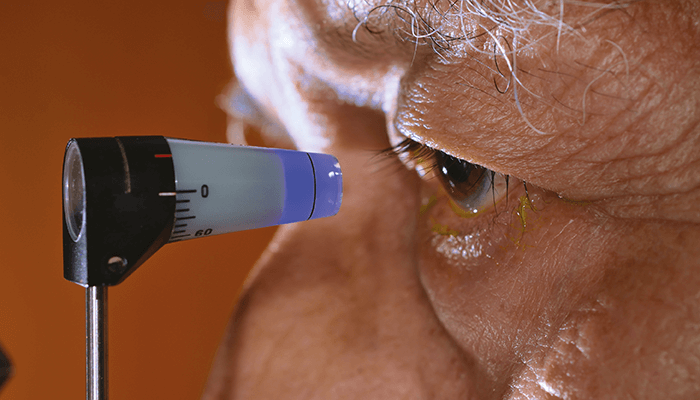
Thinner and faster. Is macular ganglion cell complex thinning associated with central visual field loss over time in patients with glaucoma? To answer this question, researchers performed a 4.7-year retrospective cohort study of 202 eyes in 139 patients at a tertiary glaucoma center (1). The results demonstrated that increased rates of macular thickness thinning during an initial follow-up period are associated with faster rates of central visual field loss over an extended period; they support the use of longitudinal macular OCT scans to assist with clinical glaucoma decision-making and guide possible therapy intensification in high-risk patients. Link
Crash pressures. Data from three French national databases were used to assess the potential effects of both glaucoma-associated visual defects and anti-glaucoma medication on driving. Analysis of 201,497 drivers showed that, although the proportion of drivers prescribed anti-glaucoma medication increased with age, those in treatment (whether prescribed one or multiple medications) were less frequently involved with crashes than controls; there was no association between these prescriptions and crash responsibility (2). The results strengthen the current safe driving guidelines for those using anti-glaucoma medications. Link
Psychological power. An evaluation of current research investigating the impact of psychological interventions in glaucoma patients was conducted through a literature review that assessed both physical and mental health results by looking at psychological symptom modulation and glaucoma control support. The analysis determined that psychological interventions, especially meditation, can play a role in the holistic care of patients with glaucoma by alleviating the mental health burden of the disease and controlling disease progression when used alongside conventional approaches. Psychological interventions offer a low-cost, noninvasive route to greater glaucoma control with few side effects (3). Link
Detection to diagnosis. Researchers conducted a cohort study to determine the length of the preclinical detectable phase (PCDP) of open-angle glaucoma (OAG). Data from a population-based OAG screening performed between 1992 and 1997 on 32,918 patients aged 57 to 77 revealed that the mean PCDP of the 2,029 included patients, when calculated twice using two different methods of analysis, was around 10 years, suggesting that reasonably long screening intervals – for example around five years – are acceptable (4). Link
Data diaries. A new study from Oregon Health & Science University, Portland, Oregon, USA, describes the methods used to process and characterize an open dataset of clinical notes from the electronic health record (EHR) that had been annotated for glaucoma treatments (5). The final dataset contains 5,520 annotated sentences, with and without medications, from the clinical notes of 480 office visits by patients seen for glaucoma by a comprehensive or glaucoma ophthalmologist between the start of 2019 and the end of August 2020. The dataset has been published online and is publicly available. Link
In Other News…
Testing time. When following glaucoma patients using OCT, more frequent testing results in shorter time to detect progression; a six-month interval provides a reasonable trade-off (6). Link
Power of pliability. Quality of life in Chinese glaucoma patients is low; resilience is an important positive factor, but sleep disturbance mitigates its effect (7). Link
Painless picking. Rapid evolution of anesthetic agents has resulted in increased safety, efficacy, and comfort – but all stakeholders’ needs must be considered when developing anesthetic plans for surgery (8). Link
Pandemic problems. Interruption of glaucoma clinic visits during the COVID-19 pandemic – and, as a result, the inability to have medications prescribed – led to increases in medication nonadherence (9). Link
Modest mitigations. Ultrasound cyclo plasty reasonably controls IOP and reduces the burden of antiglaucoma medication in POAG, but the success rate is modest (10). Link
References
- G Mahmoudinezhad et al., JAMA Ophthalmol, [Online ahead of print] (2022). PMID: 36416837.
- L Lu et al., Pharmacoepidemiol Drug Saf, [Online ahead of print] (2022). PMID: 36444481.
- ACL Wu, BNK Choy, Graefes Arch Clin Exp Ophthalmol, [Online ahead of print] (2022). PMID: 36441225.
- J Aspberg et al., JAMA Ophthalmol, [Online ahead of print] (2022). PMID: 36416831.
- JS Chen et al., Transl Vis Sci Technol, 11, 20 (2022). PMID: 36441131.
- B Melchior et al., J Glaucoma, 31, 854 (2022). PMID: 35980865.
- Q Peng et al., Front Med (Lausanne), 9, 842864 (2022). PMID: 36438057.
- A Pucchio et al., Int Ophthalmol, [Online ahead of print] (2022). PMID: 36436168.
- PG Fırat et al., J Fr Ophthalmol, [Online ahead of print] (2022). PMID: 36435659.
- FA Almobarak et al., J Clin Med, 11, 6770 (2022). PMID: 36431247
